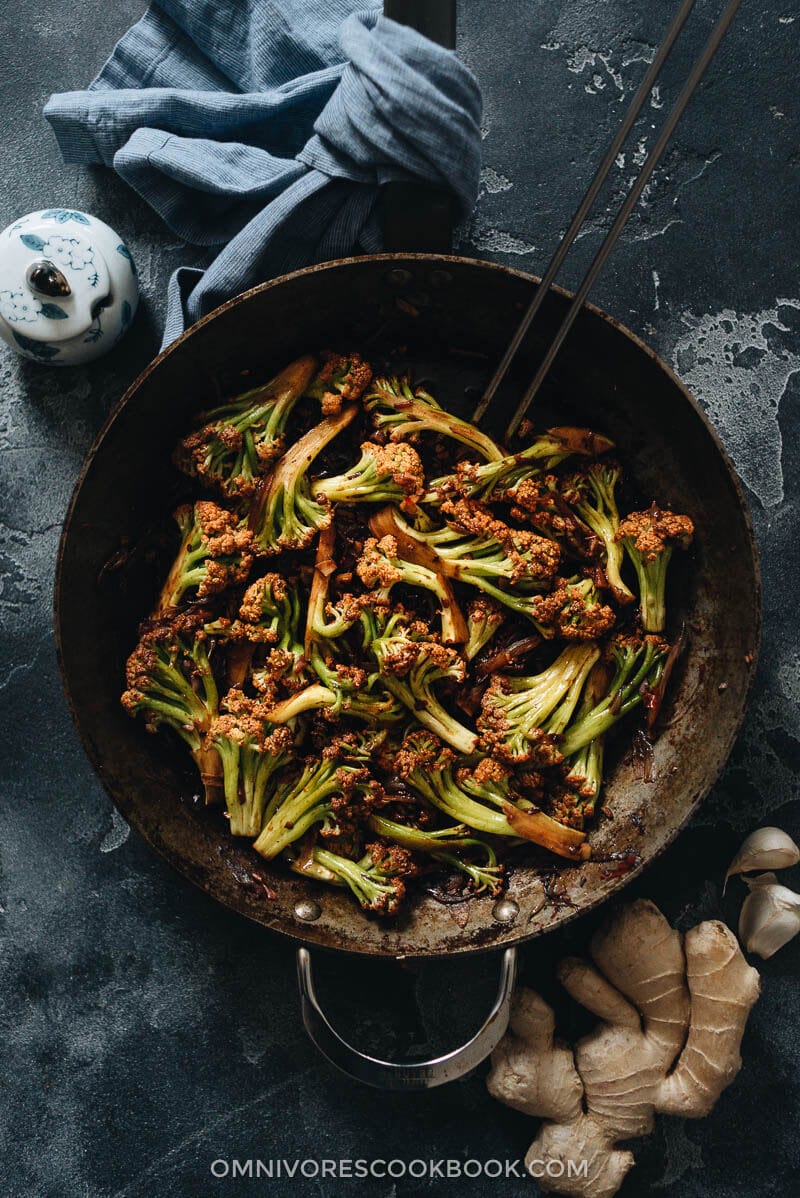
I created this dish based on the classic Chinese cauliflower dry pot recipe. It is a popular restaurant dish and there are several approaches to cooking it. The common version is made with crunchy cauliflower, dried peppers, and Chinese sausage. Sometimes with a spicy sauce. The cauliflower is usually quickly stir-fried to infuse the smoky wok air, then served in a small, shallow pot that sits on an ashtray-sized ethanol (Sterno) burner. The cauliflower continues to cook on your table and the flavor gets more intense over time. It is one of those veggie dishes featured in my Chinese vegetable stir fry recipes that are so popular and substantial enough to serve as a main.
Why this recipe
When I was developing this recipe, I made a few changes to make it more suitable for home cooking and to adapt it to a vegan dish. As you might already know, my husband started eating plant-based last year and he created his own vegan blog Gastroplant. Since then, I’ve been gradually changing my own cooking style so we can both enjoy the dishes I cook.
In the past, I mentioned that Chinese cuisine is vegetable-centered, but it has very few pure vegan dishes by default. Because chefs usually add a small amount of meat, dried seafood, chicken broth, or sauce that contains animal products to give the dish extra flavor.
After eating and cooking more plant-based dishes, I realized that simply eliminating the protein or replacing a sauce with the vegan version doesn’t translate the flavor profile completely. Instead, you have to adjust the seasoning and increase the amount of aromatics you use, so the dish will taste as rich as the original version.
That’s why I decided to use a bolder seasoning to make this traditional Chinese cauliflower dry pot. I’ve also introduced various ways to add your own protein if you’d like to add some meat to make your dinner more substantial.
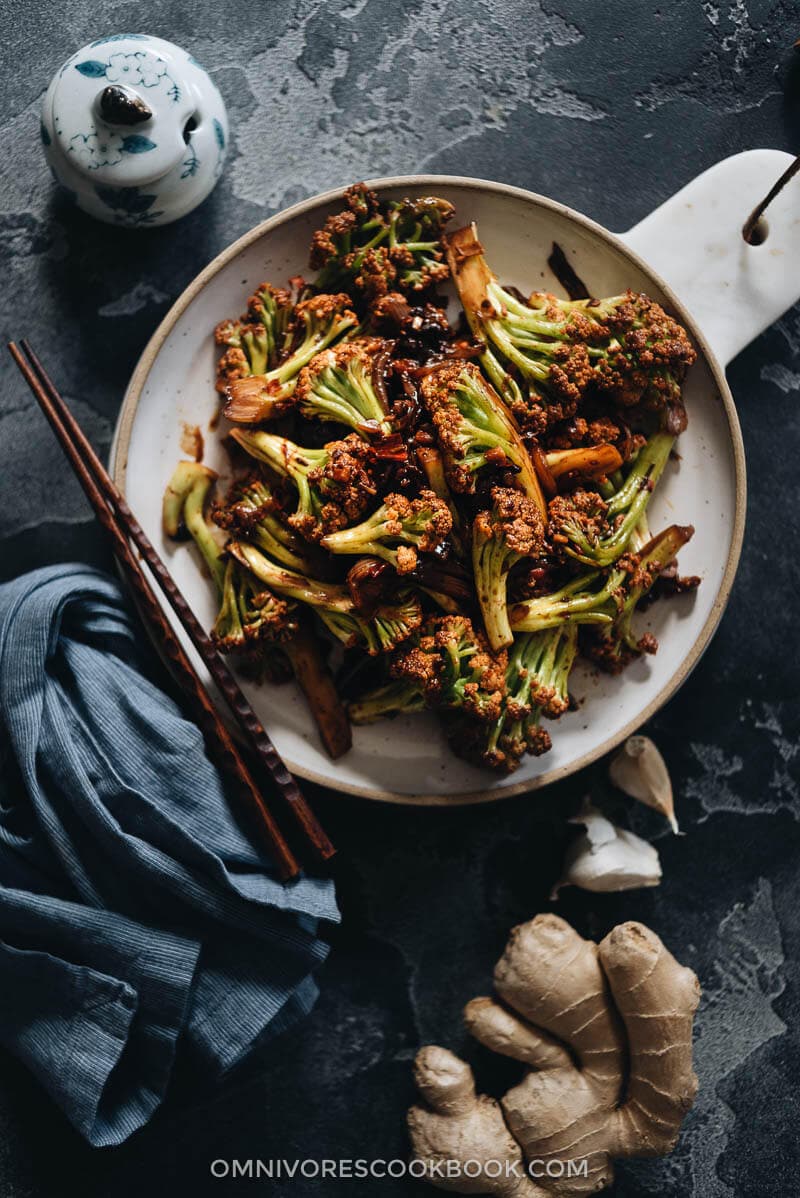
Cooking notes
Introducing Chinese cauliflower
When you visit a Chinese market, you might see a type of cauliflower that has a longer stem and smaller florets. It almost looks like broccolini. It has a lower water content, a tougher texture, and does not fall apart easily. So it’s perfect for a Chinese stir fry.
Can’t find Chinese cauliflower? No worries at all. You can use regular cauliflower to cook this dish; just reduce the cooking time (see more on this in the recipe card).
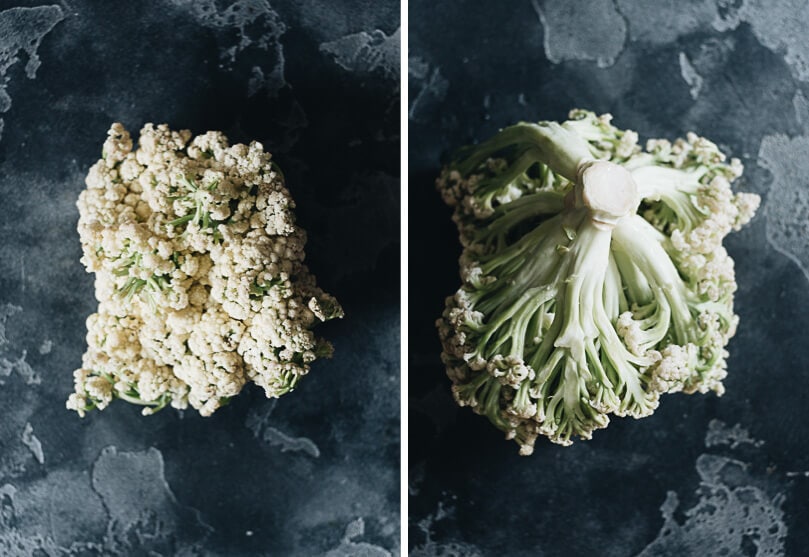
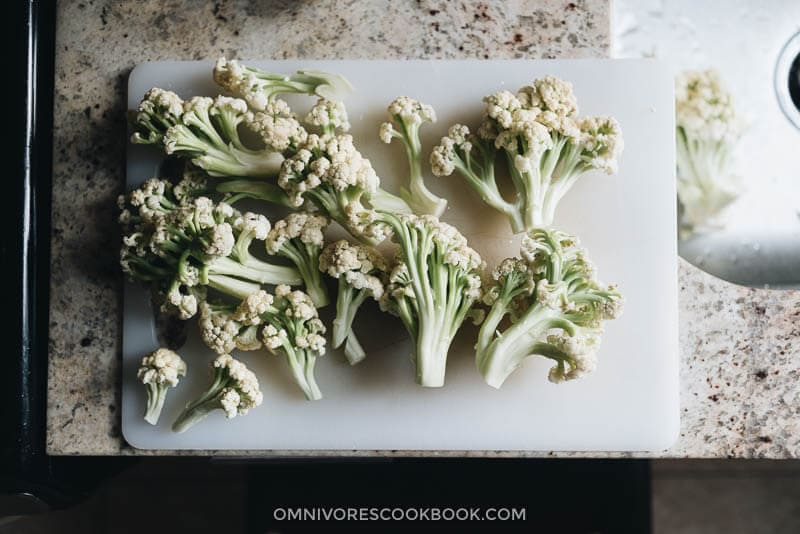
Important seasonings
Doubanjiang (豆瓣酱), also called fermented spicy bean paste, is not your average hot sauce. It is a super rich, fermented, spicy paste made with dried fava beans, fresh chili peppers, salt, and wheat flour, then aged for between one and eight years. Doubanjiang has a deep savory, spicy and quite salty taste. It is a key ingredient in classic Sichuan dishes such as Mapo Tofu and Sichuan Eggplant Stir Fry. I use this ingredient to add spiciness and extra umami to the sauce. I highly recommend the 3-year aged Doubanjiang from The Mala Market, which has a deeper umami. You can also find the regular 1-year aged doubanjiang on Amazon.
Sichuan peppercorn (Hua Jiao, 花椒) is another key ingredient in Sichuan cooking. Fresh Sichuan peppercorns have a pungent aroma that lingers around the nose. Its taste is almost indescribable: numbing, tingling, and somewhat refreshing like mint. These peppercorns add a savory, smoky, and slightly citrusy flavor to a dish, and it’s that flavor that makes genuine Sichuan food. It’s a key ingredient in many classic Sichuan dishes such as Dan Dan Noodles and Mala Chicken.
I highly recommend you purchase Sichuan peppercorns from Mala Market. They carry the freshest Sichuan peppercorns in the US, sourced directly from Sichuan. It truly makes a world of difference.
With these two ingredients, your cauliflower dish will taste so rich and satisfying and can totally be served by itself on steamed rice as a main dish.
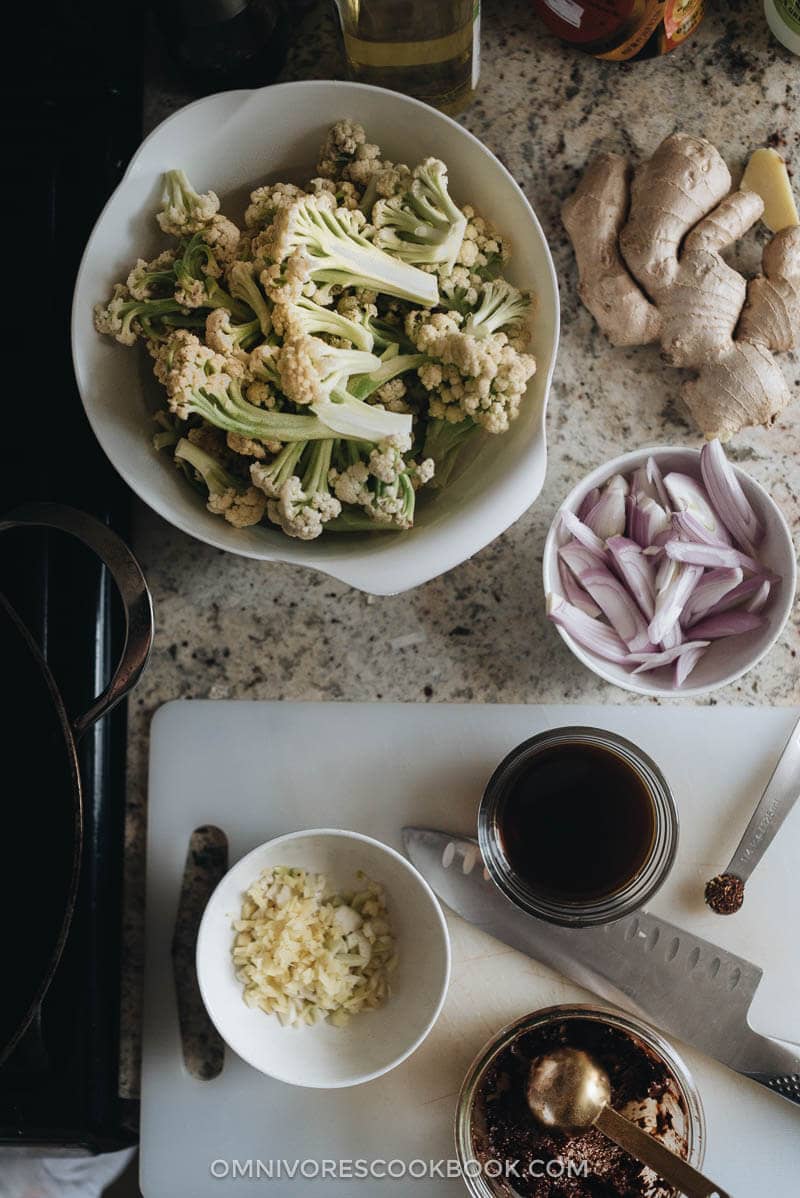
Cooking workflow
Cooking Chinese cauliflower is very simple.
- You start by sauteing the aromatics and the spices to release the fragrance.
- Then saute the cauliflower with the spices.
- Cover and braise the cauliflower with a small amount of broth until the cauliflower is cooked through and the broth is absorbed.
That’s it!
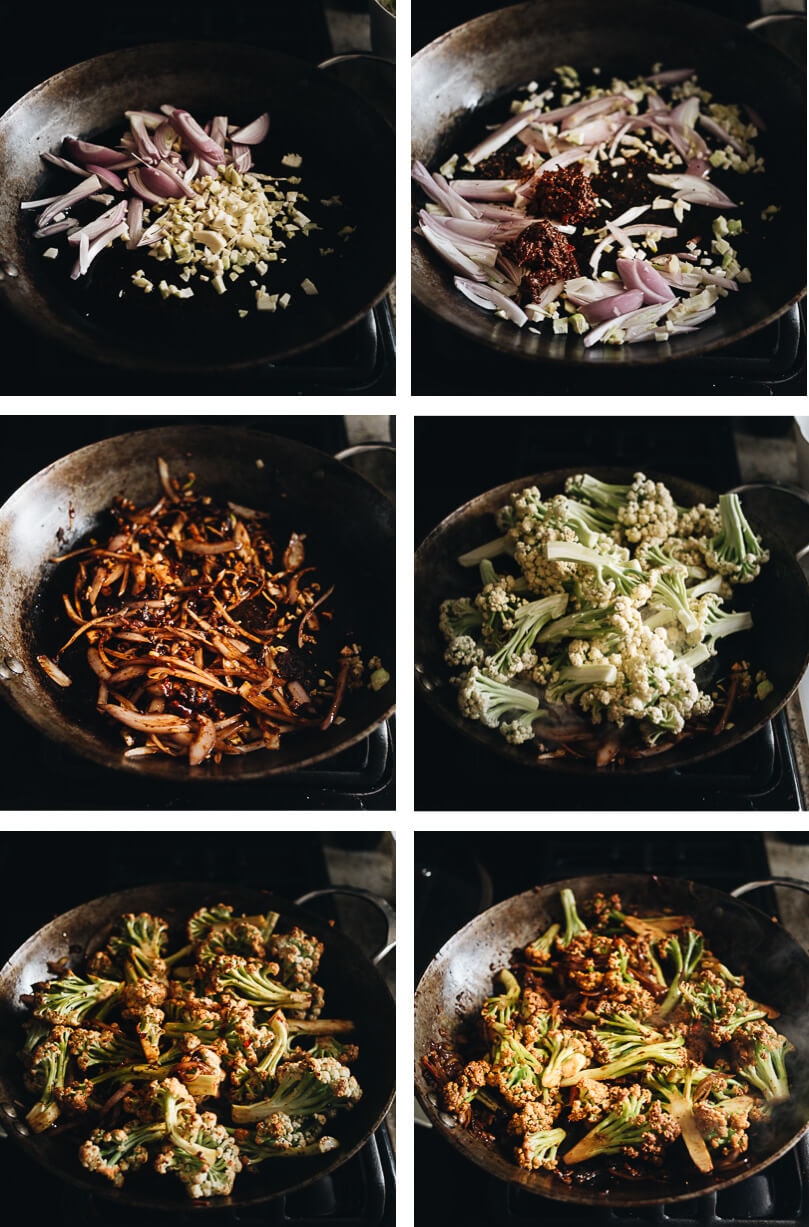
How to make the dish non-vegan
There are several ways to make the dish more substantial, so you can make a one-pot dinner by serving the cauliflower over steamed rice.
(1) Add ground meat
It’s my favorite way if I want a satisfying dinner without much prep while keeping the dish healthy.
Add 1/2 lb (225 g) ground meat between step 3 and 4, before adding the cauliflower. After step 3, move all the aromatics to one side of the pan, add a bit of oil to the other side and the ground meat. Cook the meat until it’s mostly browned, then stir to mix everything together. Then proceed to the next step to add the cauliflower.
(2) Use Spam
Less healthy but so delicious, the Spam bits will be browned and add tons of flavor to the dish. This might not be something I want to do every day but it’s hard to resist making it once in a while.
Slice half a can of Spam into small pieces and add them after step 4, before adding the sauce.
If you use this method, you might also want to reduce the doubanjiang to 1 tablespoon so the dish won’t end up overly salty.
(3) Add smoked tofu or tempeh
My husband’s favorite to add protein while keeping the dish vegan. The reason for using smoked tofu and tempeh is, they hold their shape well and won’t break apart easily. Their chewy texture also works better with the bold seasoning than regular tofu.
Chop the smoked tofu or tempeh into small pieces and add it after step 4, before adding the sauce.
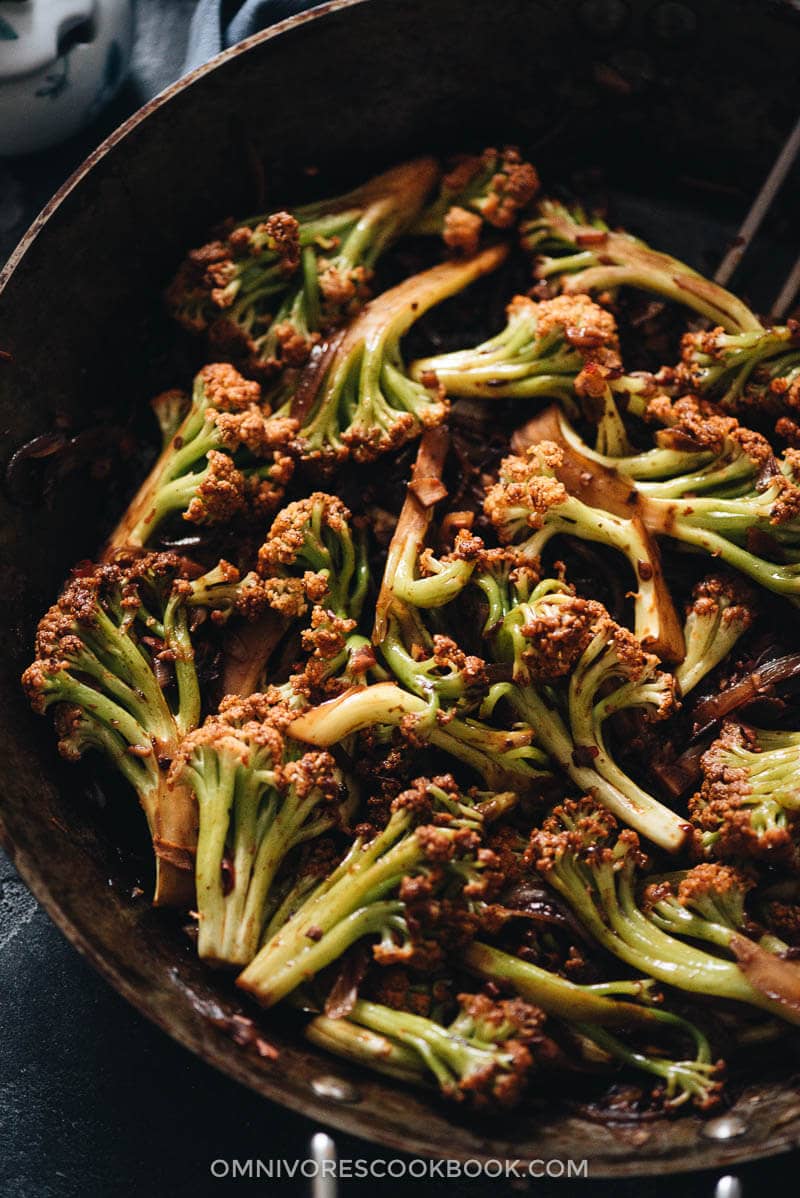
Afterthoughts
After six months of waiting, our apartment finally has gas again! It’s such great news that we can use the oven again, and cook more than one thing at a time. On the other hand, I was surprised to find that the gas stove is so much less powerful than my Iwatani Portable Gas Stove. Using the highest level of heat, it takes quite some time to heat up the pan. It’s still faster than an electric stove and easier to control the heat, but definitely not powerful enough to use a wok. It proves again that my theory was right – a wok is not suitable for most home cooks. And I will keep using my carbon steel and nonstick skillets to develop recipes that mimic the authentic taste. You can read a bit more on cooking gear and how to set up your stir fry station in this previous post.
More delicious veggie recipes
- Stir Fried Water Spinach – Two Ways
- Steamed Eggplant in Nutty Sauce (芝麻酱拌茄子)
- Stir-Fried Pea Shoots with Garlic (蒜蓉炒豆苗)
- Chinese 4-Ingredient Fried Cabbage
- Di San Xian (Fried Potato, Eggplant and Pepper in Garlic Sauce 地三鲜)
If you give this recipe a try, let us know! Leave a comment, rate it (once you’ve tried it), and take a picture and tag it @omnivorescookbook on Instagram! I’d love to see what you come up with.
Chinese Cooking Made Easy
Are you new to this website? This free email series is a great place to start. I’ll walk you through a few of my most popular recipes and show you how and why they work. You’ll quickly start to cook better Chinese food in your own kitchen.
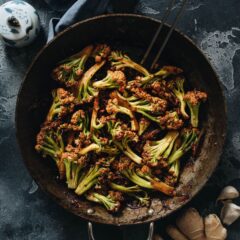
Chinese Cauliflower Stir Fry (干锅菜花)
Ingredients
- 1 small head (18 oz./500g) Chinese cauliflower (or regular cauliflower)
- 2 tablespoons peanut oil (or vegetable oil)
- 5 dried chili peppers (Optional)
- 2 shallots , sliced (or 1/2 white onion)
- 4 cloves garlic , minced
- 1 tablespoon ginger , minced
- 2 tablespoons Doubanjiang (spicy fermented bean paste), or 1 tablespoon for a less spicy and less salty dish (*Footnote 1)
- 1/4 teaspoon ground Sichuan peppercorn
Sauce
- 1/4 cup vegetable stock (or water)
- 2 tablespoons Shaoxing wine (or dry sherry)
- 1 tablespoon light soy sauce (or soy sauce)
- 1 teaspoon sugar
Instructions
- Cut the cauliflower into bite-sized florets. Rinse, drain, and set aside.
- Mix the sauce ingredients in a small bowl.
- Heat oil over medium-high heat in a large carbon steel (or non stick skillet) over medium-high heat until hot. Add the dried chili peppers, shallots, garlic, and ginger. Stir a few times to release the fragrance. Add the Doubanjiang and ground Sichuan peppercorns. Cook and stir to roast the doubanjiang, for 1 minute or so, or until the aromatics are evenly coated. If the doubanjiang looks dry and starts to burn, pour in a spoonful of Shaoxing wine (or water) and stir to bring down the pan temperature.
- Add the cauliflower. Stir and cook for 1 minute.
- Pour in the sauce. Stir again to mix well. Cover the pan. Let steam until the cauliflower turns tender. It takes 6 to 8 minutes to cook through Chinese cauliflower, and 3 to 4 minutes to cook through regular cauliflower. Check on the cauliflower every 2 to 3 minutes, stirring a few times when you check it. Add a bit of water or veggie broth if the pan gets too dry.
- Uncover. If there’s still a lot of liquid in the pan, you can turn up the heat, cook and stir a few more times to let the liquid evaporate. Transfer everything to a plate.
- Serve hot as a side or main dish over steamed rice.
Notes
- To make this dish gluten-free, use dry sherry instead of Shaoxing wine, and use coconut amino or tamari to replace the soy sauce.
- The recipe yields 2 servings as a main and 4 servings as a side. You can check the blog post above to learn how to add meat or tofu to the dish to make it more substantial.
Nutrition

Did you make this recipe?
I’d love to hear how it turned out for you! Please take a moment to leave a 5-star rating ⭐️ and share your thoughts in the comments further down the page. It really helps others discover the recipe too.
The original recipe was published by Feb 27, 2015, and updated on Jul 9, 2019.
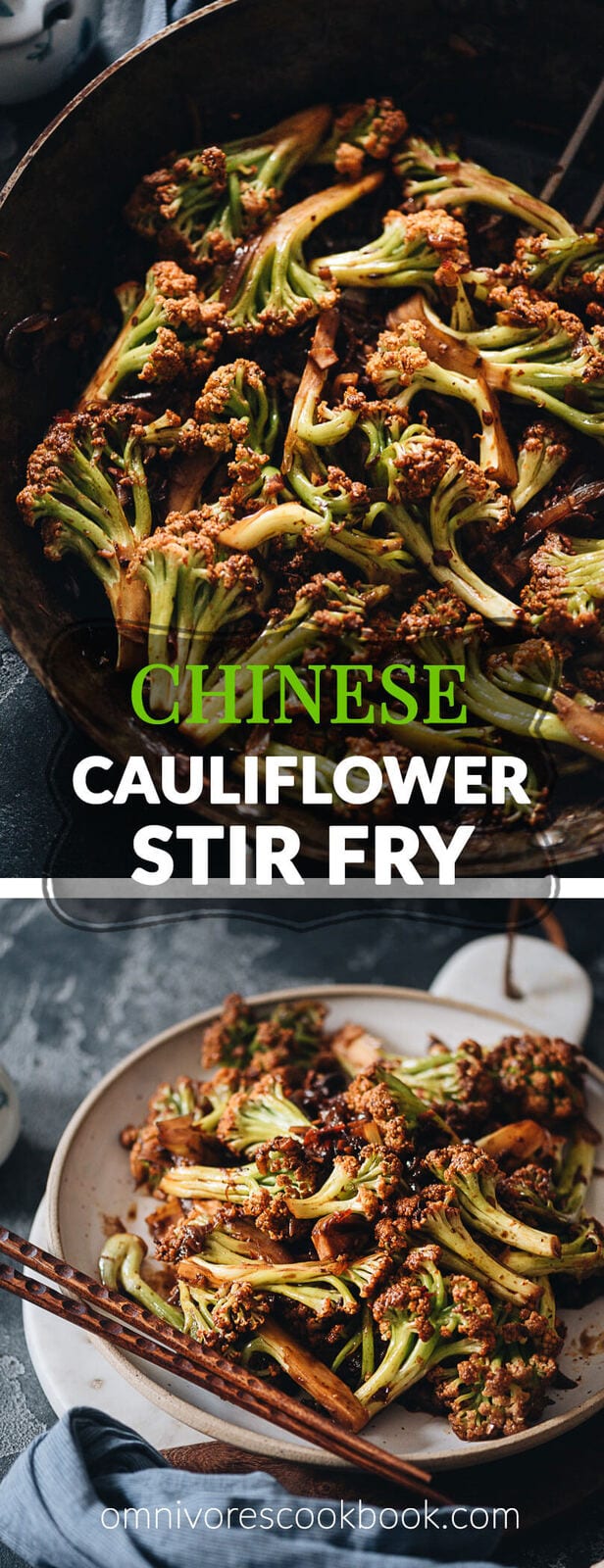

Ruth Goldman
Delish… Punto.
Jordan
Not bad, I quadrupled the peppercorn.
Patricia Lai
I didn’t add the dried chili or the peppercorns as I have children who couldn’t take that much heat, but this was still delicious albeit too spicy for my youngest. Thank you for introducing me to doubanjian! Definitely now my favourite way to prepare cauliflower, which is a vegetable I’ve been experimenting with for some time in soups, roasted, etc.
Maggie Zhu
Glad to hear you enjoyed the dish Patricia! If the dish is too spicy, you can reduce the doubanjiang and maybe add a pinch of ground paprika (adds some smokiness without adding spiciness). Also the Sichuan peppercorns are not spicy and more of a numbing sensation. I hope you can give it a try next time 🙂
Peter
I should add that the cauliflower was easily prepared in a non-stick 12″ pan while the small broccoli/chicken was done in a smaller non-stick pan. I was careful to prepare the sauces and aromatics in advance as advised and was able to complete the cooking phase along with some white rice in about 15 minutes.
Peter
This recipe is now at the top of my sides list.
Combined with a small chicken and broccoli it becomes a superb meal for two.
And finally, doubanjiang is really great stuff.
Mary Ellen Maatman
This was very good. Thank you!
Peter Beckles
Normally I would say that cauliflower is pretty blah but with that sauce it really took off.
Had this one and celtuce leaf salad today as a side to a standard barbecued chicken main.
Let me see … what did I do wrong? I reached for the vegetable stock and made beef stock sauce. (I tried to excuse the error by muttering that they look pretty much the same) and nearly forgot the green onions.
Other than that my wife thinks that doubanjiang is “too hot” and I don’t. Doubanjiang is great stuff.
The cauliflower stir fry complemented the barbecued chicken wonderfully. and is worth doing again – beef stock notwithstanding.
If I may, the sauce could be thicker and its not your recipe’s fault that I rate it at 4 stars only at my first try.
Its the beef stock!!
Cheers,
Melanie Sparkes
Hi Maggie I tried this tonight and added fermented tofu. It had a lovely savoury salty flavour and your pantry notes on it were absolutely right – like blue cheese in a mild way. Great recipie and great advice. Thank you!
Tony
Really tasty – great umami from the bean-chili paste. I used dry amontillado sherry with outstanding results.
Dena
Can I use LaoGanMa black bean chili oil instead of the fermented bean paste
Maggie
Hi Dena, you can!
Stuart
Had this as a side last night: quick to prepare and brings a healthy spicy dish to the table. Will definitely do again.
Maggie
Hi Rob, thank you for trying out this recipe! I posted it long time ago and almost forgot about it! It’s a very famous Sichuan dish in China, but I slightly adapted it into a vegetarian recipe. The original dish has bacon in it and tastes even better 🙂
Margaret
I love cauliflower! Thank you for sharing your wonderful recipe!
Margaret
Amy Tong
Love your healthy and flavorful dish! 🙂 I adore cauliflower and spicy food…but somehow never thought of combining the two! hahaha…Thanks for sharing this great idea.
Janette@culinaryginger
What a delicious way to prepare cauliflower, I’ll be trying this soon.
mira
I’m all about fresh, easy and healthy meals like this stir fry. Looks delicious! heading over to see the recipe!
Nagi@RecipeTin Eats
YES! This is how to make cauliflower interesting to me – stuff cauliflower rice or cauliflower crust pizza, THIS is cauliflower at its best! Loaded with flavours!!
Jim
Love cauliflower and broccoli and always put them in stir fries You say you like the carbon steel There are pans from Solid Teknics which I recommend you check out Some are made in the USA and some in Australia These pans ae indestructible and will never need to be replaced in your lifetime They need seasoning to start but that should be no problem. I am sure you will appreciate them
Marissa | Pinch and Swirl
Yum! Popping over now to check out the recipe…